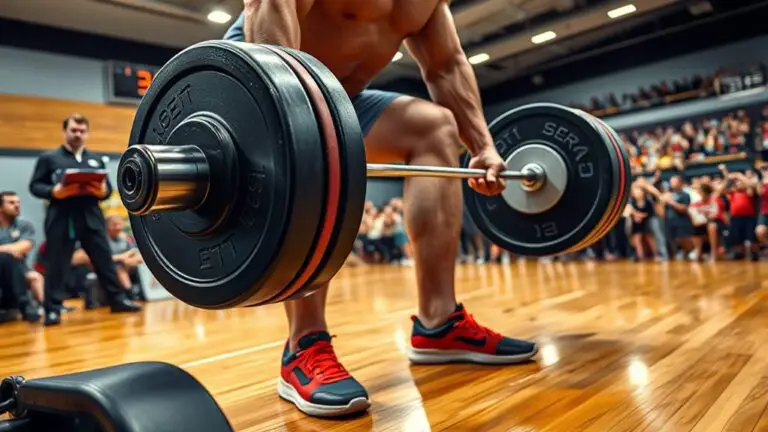How to Improve Your Bench Press Strength

To improve your bench press strength, focus on maintaining proper form with a grip just outside shoulder width and flat feet for stability. Incorporate progressive overload by gradually increasing weight and varying your reps. Don’t skip your warm-up—dynamic stretches and joint mobility exercises are essential. Prioritize recovery with good nutrition, hydration, and rest. Finally, track your progress regularly and set specific goals. By following these tips, you’ll reveal new levels of strength and performance.
Understanding Proper Bench Press Form

When you’re aiming to boost your bench press strength, understanding proper form is vital. First, start with your bench grip; it should be just outside shoulder width. This guarantees stability and control. Pay attention to your foot placement; keep your feet flat on the ground to maintain balance and power. Your shoulder alignment is key, so make certain your shoulders are retracted and pressed into the bench to protect your joints.
As you lower the bar, focus on the bar path; it should move in a straight line toward your chest. Maintain a proper elbow position by keeping your elbows at about a 45-degree angle to your body. Finally, don’t forget about your breathing technique; inhale as you lower the bar and exhale powerfully as you press it back up. Adhering to these guidelines will help you lift safely and effectively.
The Importance of Warm-Up and Mobility
Although many lifters underestimate it, warming up and improving mobility are essential for maximizing your bench press performance. A proper warm-up prepares your muscles and joints, reducing the risk of injury. Start with dynamic stretches that target your chest, shoulders, and triceps. Movements like arm circles, torso twists, and push-ups can increase blood flow and enhance flexibility.
Focusing on joint mobility is equally important. Spend time loosening your shoulders and wrists, as these areas bear the brunt of the bench press. Incorporate exercises like band pull-aparts or shoulder dislocates to verify your joints are ready for the load.
Progressive Overload Techniques

To build your bench press strength effectively, you need to embrace progressive overload techniques that gradually increase the demands on your muscles. Start with progressive resistance by incrementally increasing the load you lift. Aim to adjust your rep range, focusing on both higher and lower reps to stimulate muscle growth. Volume manipulation is also key; consider varying the total number of sets and reps per session.
Don’t forget about training frequency—hitting the bench press multiple times a week can enhance gains. Intensity variation will keep your muscles guessing, so mix in heavier days with lighter, higher-rep days. Exercise variation can prevent plateaus; incorporate different bench press styles or grips. Finally, plan deload weeks to allow recovery and prevent injury while maintaining strength. By strategically applying these techniques, you’ll safely boost your bench press performance over time.
Accessory Exercises for Bench Press Strength
Incorporating accessory exercises into your routine can greatly enhance your bench press strength. These exercises not only support your primary lifts but also improve your overall stability and power. Here are three effective options to evaluate:
Incorporating accessory exercises can significantly boost your bench press strength and enhance overall stability and power.
- Bench Press Variations: Try using different grips or incline/decline angles to target various muscle groups.
- Resistance Band Training: Use bands for explosive power movements, helping you develop speed and strength through the entire range of motion.
- Grip Strength Exercises: Incorporating exercises like farmer’s walks can enhance your grip, which is essential for safe and effective lifts.
Additionally, consider including reverse curls as they target the biceps and can contribute to better overall upper body stability. Don’t forget about shoulder stability work and utilizing stability training tools like balance boards or stability balls to improve your upper body exercises. By focusing on these strength training accessories, you’ll build a solid foundation that supports your bench press goals while prioritizing your safety.
The Role of Nutrition in Strength Training

Nutrition plays an essential role in maximizing your strength training efforts, including your bench press performance. To fuel your workouts effectively, focus on macronutrient ratios that support muscle growth. Aim for a balance of protein sources, healthy fats, and carbohydrates to keep your energy levels high.
Meal timing is important; consider pre workout snacks that provide quick energy and post workout meals rich in protein to aid recovery. Implement hydration strategies throughout your training to maintain performance and prevent fatigue.
Don’t overlook micronutrient balance—vitamins and minerals play critical roles in muscle function. Also, be mindful of supplement choices; they can support your diet but shouldn’t replace whole foods. Prioritize food quality in your meal planning to guarantee you’re getting the nutrients needed for peak strength training. Finally, think about nutrient timing to maximize benefits around your workouts.
Recovery Strategies to Enhance Performance
Recovery is just as essential as your workout when it comes to boosting your bench press strength. You need to prioritize sleep and rest to allow your muscles to repair and grow. Additionally, proper nutrition plays a key role in supporting your recovery process, so don’t overlook it.
Sleep and Rest Importance
While many lifters focus on their training routines and workout plans, the importance of sleep and rest can’t be overlooked when it comes to improving your bench press strength. Proper sleep supports recovery phases, allowing your muscles to rebuild and grow stronger. To maximize your performance, consider these key factors:
- Sleep cycles: Aim for 7-9 hours of quality sleep to enhance muscle recovery.
- Rest duration: Schedule enough downtime between workouts to prevent overtraining and reduce injury risks.
- Sleep quality: Create a restful environment, limiting distractions to guarantee deep, restorative sleep.
Nutrition for Muscle Recovery
To support your bench press gains, what you eat plays a significant role in muscle recovery. Focus on protein timing by consuming lean protein within 30 minutes post-workout. Incorporate healthy carbohydrate sources to replenish glycogen stores and aid recovery. Staying hydrated is essential, so develop effective hydration strategies throughout your training. Aim for a micronutrient balance by including a variety of fruits and vegetables in your meals. Maintain meal frequency to guarantee your body gets a steady supply of nutrients. Don’t forget about pre-workout meals to fuel your sessions. Consider nutrient-dense post-workout snacks and recovery supplements to enhance muscle repair. By prioritizing these aspects, you’ll set a solid foundation for peak performance and recovery.
Mental Focus and Visualization Techniques
How can you harness the power of your mind to boost your bench press strength? Mental focus and visualization techniques can greatly enhance your performance while ensuring safety. Consider these strategies:
- Mental imagery: Visualize yourself successfully lifting the weight before you even approach the bench.
- Pre-lift rituals: Develop a consistent routine that helps you mentally prepare and reduces anxiety.
- Positive affirmations: Use encouraging phrases to boost your confidence right before your lift.
Incorporating concentration exercises and mindfulness training into your routine builds mental resilience. Performance visualization not only prepares you for the lift but also helps in honing your focus techniques. By practicing these visualization practices consistently, you’ll find that your mental preparation directly translates into better strength outcomes. Remember, a strong mind can be just as essential as a strong body when it comes to achieving your bench press goals safely.
Tracking Progress and Setting Goals
Tracking your progress and setting clear goals is essential for improving your bench press strength. By establishing benchmarks and utilizing progress journals, you can see how far you’ve come and identify areas for growth. Don’t forget to adjust your goals regularly to keep challenging yourself and stay motivated.
Establishing Clear Benchmarks
Establishing clear benchmarks is essential for anyone looking to improve their bench press strength. By setting specific goals, you can guarantee safe and effective performance evaluation. Here are three ways to start your benchmark setting:
- Determine your current max: Know your one-rep max to measure progress effectively.
- Set incremental goals: Aim to increase your max by small, manageable weights over time.
- Track your lifts regularly: Consistently evaluate your performance to adjust your training plan as needed.
Utilizing Progress Journals
While progress can sometimes feel slow, utilizing a progress journal can greatly enhance your bench press training. By consistently logging your workouts, you can track your strength over time, making it easier to identify patterns and areas for improvement. You’ll want to note not just the weights lifted, but also how you felt during each session. This helps guarantee you’re lifting safely and effectively, reducing the risk of injury. Setting realistic goals based on your journal entries keeps you motivated and focused. As you see your improvements, it boosts your confidence and reinforces your commitment to your training. Regular strength tracking through your journal helps you stay accountable and informed on your journey to a stronger bench press.
Adjusting Goals Regularly
As you keep a progress journal, it becomes clear that adjusting your goals regularly is key to continuous improvement in your bench press strength. Effective goal setting involves using SMART goals that are specific, measurable, achievable, relevant, and time-bound. Here are some strategies to contemplate:
- Set flexible targets to adapt to your performance evaluation.
- Celebrate milestone achievements to boost motivation and maintain focus.
- Use success metrics to track your progress and refine your approach.
Frequently Asked Questions
How Often Should I Bench Press Each Week?
When considering how often you should bench press each week, it’s essential to find a balance that works for your body. Generally, bench press frequency can range from one to three times a week, depending on your training split and overall goals. If you’re just starting, aim for once a week to allow your muscles to adapt. Always prioritize safety, ensuring proper form and adequate rest to prevent injuries.
Is It Normal to Plateau in Strength?
It’s completely normal to hit a plateau in strength; many lifters experience this at some point. Plateau causes can range from inadequate recovery to nutritional deficiencies. To overcome plateaus, consider adjusting your training routine, incorporating varied exercises, or increasing rest periods. Also, make sure you’re fueling your body properly with a balanced diet. Remember, patience is key, and listening to your body will help you progress safely and effectively.
What Equipment Do I Need for Bench Pressing?
Did you know that nearly 70% of lifters experience injuries due to improper equipment? To safely bench press, you’ll need some essential benching gear. A sturdy bench and a barbell are must-haves, along with weights to customize your load. Don’t forget safety measures like collars to secure your plates and a spotter for support. Exploring bench press variations can also enhance your training and keep things interesting while ensuring you stay injury-free.
Can I Bench Press Without a Spotter?
Yes, you can bench press without a spotter, but it requires some safety precautions. Using a weight that’s manageable for you is key, and consider using safety pins or a squat rack to catch the bar if it slips. Alternative techniques like dumbbell bench pressing can also be safer, allowing you to lower the weights independently. Always stay aware of your limits, and don’t hesitate to ask for help if you need it.
Should I Use Wrist Wraps for Bench Pressing?
So, you think wrist wraps are just for show? Well, they can actually be quite beneficial! They provide extra support and stability, reducing the risk of injury during heavy lifts. However, there are drawbacks; relying too much on them might weaken your wrists over time. If safety’s your priority, consider using them when pushing your limits, but balance is key. Don’t forget to strengthen those wrists without wraps too!





